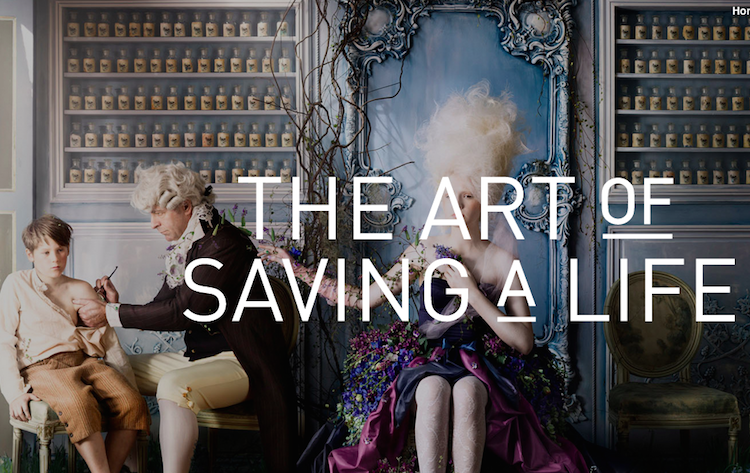By Rachel Wallace
The Art of Saving a Life Project has found a way to make the debate over vaccines into a little more than just a back and forth conversation on Twitter. The project was commissioned by the Bill & Melinda Gates Foundation, and features more than 30 artists who created pieces that tell the story of vaccines using a wide range of different mediums. The project was unveiled over the course of January 2015, and is now online at artofsavingalife.com. Each artist was allowed to create anything that was inspired by the stories and impact of vaccines.
Artist and participant Vik Muniz said in a behind the scenes video for the project that the fact that vaccines are made of poison is poetic. Vaccines use a disease to create a cure, which is similar to artists turning their pain, struggles and feelings into something that can be shared with others.
“Artists always make you think about other people’s lives,” Muniz says. And looking at the pieces from the project, you can’t help but think about the subjects as tangible individuals whose lives were drastically impacted by being vaccinated. In the abstract discussion about whether or not parents have a right to not vaccinate, that feeling of empathy for those saved by vaccines is often lost.
Each artist seems to have been inspired by something different. Christoph Neimann, whose work has appeared on the cover of The New Yorker, created a story told through illustrations, which show the challenges that arise when transporting vaccines. The illustration, he said was the perfect medium because it transcends language. For such a truly global issue, visual art can raise awareness in a unique way.
Dr. Orin Levine is the director of the Gates Foundation’s vaccine-delivery program, and told the Wall Street Journal that the Art of Saving a Life project was not focused on adding to the anti-vaccination controversy, but rather to highlight the good work that scientists are doing throughout the world and to emphasize it’s importance in a way that is easy for people to digest—art. He also said that in the parts of India and Africa where diseases like bacterial meningitis periodically wipe out populations, no one seems to have the same concerns about vaccines as in the United States. The threat of disease is too great. According to the project’s website, “One in five children worldwide are not fully protected with even the most basic vaccines. As a result, an estimated 1.5 million children die each year—one every 20 seconds—from vaccine-preventable diseases such as pneumonia and rotavirus.”
This endeavor is an example of the intersection between science and art, but it also shows how technology and art collide. The website is an incredible experience that features each piece of work in an accessible way, and includes a small biography of each artist, the story behind the inspiration, and photos or videos that take you behind the scenes of the artist’s creative process. More importantly, this artistic expression shows the intersection of science and humanity.
 ABOUT THE WRITER
ABOUT THE WRITER
Rachel Wallace is a graduate of the University of South Carolina, where she studied psychology, journalism, and warm weather. She recently moved back to her home state of New York to attend the Columbia Publishing Course and pursue a career in writing and editing. Some of her interests include poetry, hip-hip, yoga, and YouTube. She is adventurous when it comes to food and passionate about traveling. Her favorite places to be include London and the New York Renaissance Faire.
Image of vaccine via Shutterstock.



